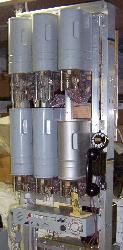 | Jan 2005 - Jan 2008 |
| Doug's SxS Switch |
 | Jan 2005 - Jan 2008 |
 | The proposal is based around the Linux-based Asterisk open source PBX, so I have been working on the configuration of a computer to run Linux and then load up and compile the Asterisk software. So far I have had some problems with the version of Linux I tried since it appears to not include all the modules needed to successfully compile the PBX software. At this writing I am downloading a later version of Linux to try. I was successful, however, in finding on eBay a very affordable trunk card for the Asterisk PBX and have it already in hand. I still need a station card and I am on the lookout for one of those, too. |
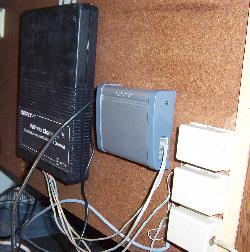 |
10 February 2005 -- A nasty water main break over near work has work closed today so I took the opportunity of "found time" to neaten up the
Asterisk PBX installation and its connections to the step switch. First, I mounted the Sipura ATA box and Mitel Smart-1 dialer unit behind
my computer desk, pictured at left. The Sipura SPA-2000 is the small gray box, and the Mitel Smart-1 dialer is the black box to the left. These
items could actually be mounted just about anywhere, including near the switch, but my thinking is to
keep all the computer-related stuff by my main computer and Internet and network connections. Wiring behind the computer desk was connected to the outgoing trunks
on the switch as well as a step switch station line. The Asterisk PBX machine was placed next to my computer desk and hooked into the network and the step switch line for the incoming calls. The machine is pictured at right and has an old WE500 sitting atop it which is plugged into one of the outgoing FXS ports on the Sipura ATA. It is my "console" telephone of sorts to be able to test outgoing VoIP calls. | 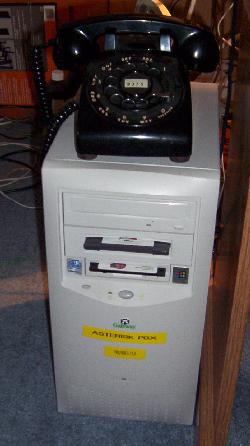 |
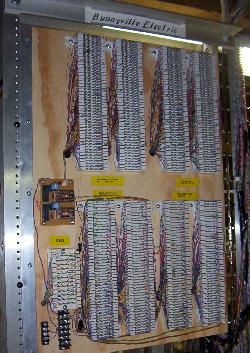 | 19 February 2005 -- Worked out a vexing problem with the step switch and VoIP interfaces. I had a weird problem where
if I used DTMF ("Touch Tone") to dial out on a VoIP trunk, the switches would perform correctly but drop the connection as soon as it selected
the trunk into the VoIP ATA, as if the calling station had hung up, which it hadn't. The line finder, seeing the station off-hook, would jump to life again and
search for the line and return dial tone from the first selector again. Sometimes dialing the VoIP trunk again would result in the selector successfully seizing a
VoIP trunk, and sometimes it wouldn't. If I used a rotary phone, everything worked fine. After trying different variables in the equation I finally came to the
conclusion that the holding bridge on the DTMF-to-pulse converter on the switch paths was loading down the line to the VoIP box too much so that there
wasn't enough current for the "A" relay in the selector to hold the switch train. The solution, or at least a work-around, was to wire the trunks to
the Sipura box over at the second-to-last and last terminals on the "1" level so that by the time the selector hunts/rotates over there the holding
bridge in the DTMF/pulse converter had dropped out. That holding time isn't adjustable, unfortunately, and a better solution would be more current
available from the Sipura box, but that isn't adjustable, either. However the problem has been worked around and now DTMF stations can dial out successfully
on VoIP. Pictured at left is the rear sleeve & line termination panel on the switch and the VoIP trunk board is on the left edge, just above the small punch block and screw terminal blocks. |
 29 March -- No step switch improvements to report, but an interesting VoIP/Step Switch interface item to talk about. A soft phone client like
Firefly can be configured as an authenticated client to an Asterisk machine so that it can appear as an extension on the Asterisk PBX. Over the Easter weekend I
went visiting to a friend's house 300 miles away, and on arrival there I was able to start up my laptop with configured Firefly client and through my friend's
wireless access point and broadband Internet access I was able to dial into the step switch back home to report my safe arrival to the folks back home. Likewise,
the folks at home could call me at my friend's on my Firefly client from a step switch station at home. I had previously built up an interface so I could plug
in an older "G" style handset to the microphone and speaker ports on the laptop for use with Firefly, and it worked very well on my trip -- and no
long distance charges!
29 March -- No step switch improvements to report, but an interesting VoIP/Step Switch interface item to talk about. A soft phone client like
Firefly can be configured as an authenticated client to an Asterisk machine so that it can appear as an extension on the Asterisk PBX. Over the Easter weekend I
went visiting to a friend's house 300 miles away, and on arrival there I was able to start up my laptop with configured Firefly client and through my friend's
wireless access point and broadband Internet access I was able to dial into the step switch back home to report my safe arrival to the folks back home. Likewise,
the folks at home could call me at my friend's on my Firefly client from a step switch station at home. I had previously built up an interface so I could plug
in an older "G" style handset to the microphone and speaker ports on the laptop for use with Firefly, and it worked very well on my trip -- and no
long distance charges!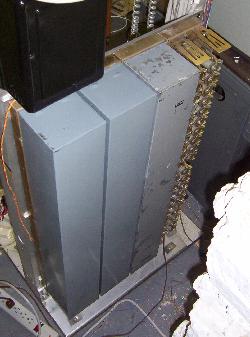 | 5 April -- Finished wiring in the last plate of line & cutoff relays. Yesterday the plate was bolted to the switch frame and the first ten lines' worth of relays was connected and then tonight the last ten were hooked up. There are now 80 dialable stations on the switch. One line has a broken line relay, but that line has been permanently busied out so that folks dialing in from the CNET have a busy line to dial to so the busy tone can be heard. It is most gratifying to have a significant portion of the switch now built. Things on the yet-to-do list include a release battery alarm, all circuits busy tone, and quite possibly hooking up the reverting ring selector I have. |
 Big news on the CNET today! A few weeks ago a gent in the UK learned of the CNET through this page and contacted me by email.
It turns out he has his own very impressive step switch and he expressed an interest in Asterisk and perhaps linking his British Strowger switch into the CNET. Today
that event is closer to becoming a reality! He has his Asterisk machine up and running and is tweaking the configuration files and was able to dial into my
switch! We had a brief chat and I rang him back on the line he has currently working. There are a number of issues that he has to work
out in his setup, but he's pretty close to being fully online with the first overseas switch on the CNET. Congrats, Jon!
Big news on the CNET today! A few weeks ago a gent in the UK learned of the CNET through this page and contacted me by email.
It turns out he has his own very impressive step switch and he expressed an interest in Asterisk and perhaps linking his British Strowger switch into the CNET. Today
that event is closer to becoming a reality! He has his Asterisk machine up and running and is tweaking the configuration files and was able to dial into my
switch! We had a brief chat and I rang him back on the line he has currently working. There are a number of issues that he has to work
out in his setup, but he's pretty close to being fully online with the first overseas switch on the CNET. Congrats, Jon! 14 January 2006 -- Today I put together a small peg counter for my switch. A peg counter is a device that keeps track of calls on a switching device. In my case
I wired the counters to the selectors which conveniently have an output for just this sort of task. When a call is dialed to the next working switch the selector puts a
momentary ground on a supervisory lead. That lead goes back to the counter.
14 January 2006 -- Today I put together a small peg counter for my switch. A peg counter is a device that keeps track of calls on a switching device. In my case
I wired the counters to the selectors which conveniently have an output for just this sort of task. When a call is dialed to the next working switch the selector puts a
momentary ground on a supervisory lead. That lead goes back to the counter. 5 February 2006 -- I finally completed and installed the fuse panel that I started who knows how long ago. I think it's been over a year. Also on the
panel is a circuit that I got from another switcher that is a relay-based flip flop circuit. I have wired that in to the line finders on the switch so that
succeeding calls are alternated back and forth between the two finders, instead of almost every call attempt going through the first line finder. In a way, this circuit
is an allotter, like would be used on Automatic Electric step gear. The circuit works well, and the two panel mounted lamps on the left side of the
fuse panel are part of the circuit.
5 February 2006 -- I finally completed and installed the fuse panel that I started who knows how long ago. I think it's been over a year. Also on the
panel is a circuit that I got from another switcher that is a relay-based flip flop circuit. I have wired that in to the line finders on the switch so that
succeeding calls are alternated back and forth between the two finders, instead of almost every call attempt going through the first line finder. In a way, this circuit
is an allotter, like would be used on Automatic Electric step gear. The circuit works well, and the two panel mounted lamps on the left side of the
fuse panel are part of the circuit.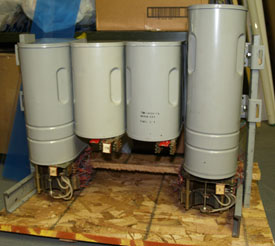 | 5 May 2007 -- Received an interesting package from a web page reader this week -- thanks, Paul!! I am in possession of a
small shelf section with some switches, namely a selector, two outgoing repeating trunk plates, and a connector. Apparently in a previous
life this was a demo switch of some kind. I have been wanting to assemble a portable demonstration switch for some time now and this will make
the perfect base for just that sort of switch. The shelf section will hold up to four switches or other apparatus. The thinking at the moment is to configure the demo switch with a line finder, a selector and a connector, perhaps using a party line connector (I have a couple in stock!), which could increase the number of lines that could be configured. Some planning in the engineering of the switch will be needed to connectorize everything so that the switches can be easily installed or removed from the frame to transport it because this old switch stuff is pretty heavy. The unit as pictured weighs in excess of 70 lbs. |